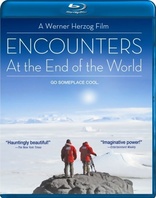Encounters at the End of the World Blu-ray Movie
HomeEncounters at the End of the World Blu-ray Movie 
Image Entertainment | 2007 | 100 min | Rated G | Nov 18, 2008Movie rating
7.4 | / 10 |
Blu-ray rating
| Users | 4.0 | |
| Reviewer | 3.0 | |
| Overall | 3.7 |
Overview
Encounters at the End of the World (2007)
Filmmaker Werner Herzog travels to the Antarctic community of McMurdo Station, on Ross Island, the headquarters for the National Science Foundation and home to eleven hundred people during the austral summer. McMurdo is a gathering place for people who want to step off the map and where everyone seem to be full-time travelers and part-time workers. Beyond the settlement, Herzog ventures from the under-ice depths of the Ross Sea to the brink of the Mount Erebus volcano. Over the course of his journey, nature in the wild shares equal time with human nature and he encounters many a colorful character along the way.
Narrator: Werner HerzogDirector: Werner Herzog
| Documentary | Uncertain |
| Nature | Uncertain |
Specifications
Video
Video codec: MPEG-4 AVC
Video resolution: 1080/60i
Aspect ratio: 1.78:1
Audio
English: DTS-HD Master Audio 5.1
English: Dolby Digital 5.1
English: LPCM 2.0
Subtitles
English, Spanish
Discs
50GB Blu-ray Disc
Single disc (1 BD)
Playback
Region A (locked)
Review
Rating summary
| Movie | 4.0 | |
| Video | 2.5 | |
| Audio | 4.0 | |
| Extras | 3.5 | |
| Overall | 3.0 |
Encounters at the End of the World Blu-ray Movie Review
Antarctica arrives at your front door courtesy of Werner Herzog.
Reviewed by Dustin Somner March 20, 2009Encounters at the End of the World is the latest documentary by Werner Herzog (acclaimed director of the 2005 documentary, Grizzly Man). 2007 must have been a busy year for Herzog, considering he completed this film and Rescue Dawn (his first Hollywood production) in the same year. While it may not go down as one of the best films of his career, Encounters is still a fine piece of work, that takes the viewer on a fascinating trek to various destinations within Antarctica.
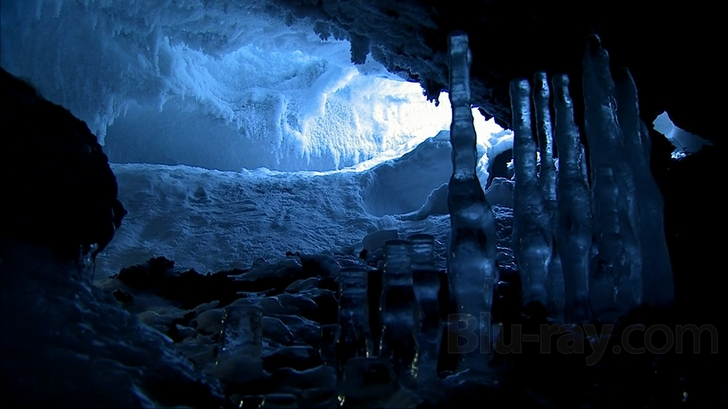
Just one of the many beautiful shots that will grace your screen.
The film begins with a brief narration from Herzog, explaining the elements that influenced his decision to make Antarctica the basis for his next documentary. One of his best lines in the film is regarding his unwillingness to continue the trend in recent years of focusing on penguins. Granted we still have a segment on penguins in this film, but it shows the humorous side of Herzog, as he successfully attempts to interject some wit in between his more ominous and philosophical narrative segments.
Since the McMurdo Station is the jumping-off point for the other locales in the film, it is appropriate that the adventure begins there. The station was originally founded back in the late-1950’s, and has expanded to include such amenities as a bowling alley, and an aerobics studio. Given the current population of over 1000 residents at McMurdo Station, it’s not too surprising to find several unique characters, and Werner seems to have a knack for finding people with unusual stories to tell. After interviewing a couple of the men that work and live at McMurdo Station, the documentary crew is put through the Happy Camper 2-day survival school. This segment includes an amusing training session called Buckethead, which is meant to simulate white-out conditions. Everyone at McMurdo is required to participate in this survival training prior to going out to other locations around Antarctica.
Through the rest of the film, we get a front row seat as Werner and his crew visit five research stations around Antarctica. We are introduced to researchers that study seals, penguins, underwater marine life, volcanoes, and micro-organisms known as nutrinos. In between those segments, Werner offers a collection of people-focused interviews with the “unique characters” I described earlier, and gives an adequate history lesson on exploration in Antarctica.
I went into Encounters without expectations, and was pleasantly surprised with the entertainment value of the film. It takes a good documentary to hold my attention, so I would imagine those that love documentaries will find a lot to enjoy here. In my opinion the most interesting segment was the one that covered the divers in Antarctica. These brave gentlemen jump into the icy water through a hole in the ice, with no compass or harness, to collect samples or take pictures of the underwater life they find. Some of the creatures in the video are truly out of this world, and look more like something you’d see in a science fiction film.
Herzog’s strength as a filmmaker lies in his ability to always pull entertainment value out of thin air. At one point, he interviews a penguin researcher, who has spent far too much time removed from society. When the conversation seems to go nowhere, he tries to liven it up by asking questions about homosexuality among penguins, or whether a penguin can go insane. Most documentary filmmakers would shy away from questions like that, but not Werner Herzog. I also appreciate his blunt honesty in the narration of his films, as it tends to add additional weight to what we are viewing onscreen. Statements such as “Many researchers have grave doubts about our long-ranging presence on this planet”, draw you out of your armchair comfort, and make you question why these researchers have come to that conclusion. I’d hate to stir a hornet’s nest by speaking about such matters as global warming, but Herzog seems perfectly comfortable with making his opinion known (and regardless of your feelings, it is better to have a filmmaker that is honest than one who tries to walk the fence).
Another interesting question Herzog raises in the film, is whether modern exploration is even possible anymore. He briefly looks back through the history of human exploration, and expresses his sadness with the idea that we have conquered the final two undiscovered places on the planet (which he believes are Mt. Everest and Antarctica). I never really thought about this before, but modern adventurism has been reduced to cheap stunts and ridiculous antics to win a place in the Guiness Book of World Records. Herzog uses the example of a man who has bounced on a pogo stick in every continent except Antarctica, and simply asks the question “Is this what adventure has been reduced to in the 21st century?”
Encounters at the End of the World Blu-ray Movie, Video Quality 
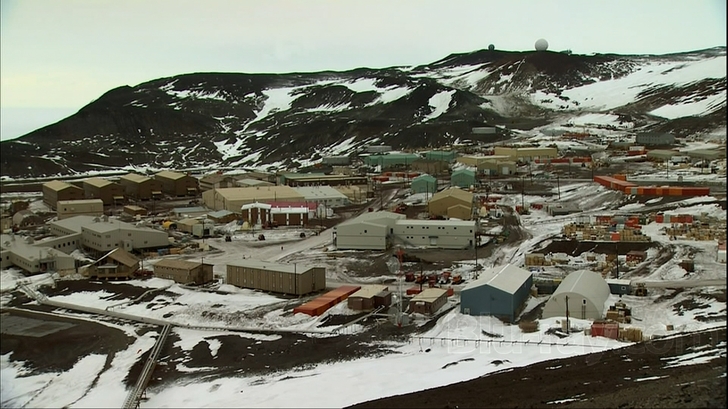
Get ready to be disappointed….Encounters is presented in a largely disappointing 1080i transfer using the AVC codec. I'm not sure if the film was originally shot in a higher resolution, so I cannot comment on the accuracy of this transfer compared to the original source material, but I would assume that a recent documentary would be filmed using cameras that are capable of full 1080p. Motion blurring seems to be the prominent flaw in the picture, and is quite distracting in several scenes. Even subtle motion during interviews (like the swaying of the interviewee's head) will lead to ghosting. If you look at some of the screen captures, you'll see the difficulty I had in obtaining decent looking frames as examples. Some of them looked downright awful, with moving objects reduced to a series of horizontal scan lines. If you do see what I'm talking about in the screenshots, just keep in mind the picture looks a lot smoother than the individual shots, but still suffers from the problem I've described. Another issue was the presence of stair-stepping lines or jaggies, (which shouldn't happen with the resolution jump to high-definition) which can be seen around the window frame in screenshot #16. Grain is kept to a minimum, but there is a bar scene around the halfway point, where there is heavy digital noise throughout the picture.
On the bright side, I didn't detect any edge enhancement, black levels were appropriately deep, and contrast was solid. Most of the underwater footage (which is the best in the film) is shot with almost zero movement, so at least the detail was nicely rendered in those scenes. Overall, the cons outweigh the positives, and I'm disappointed that a "visual" film such as this was not given a little more attention in the video department.
Encounters at the End of the World Blu-ray Movie, Audio Quality 
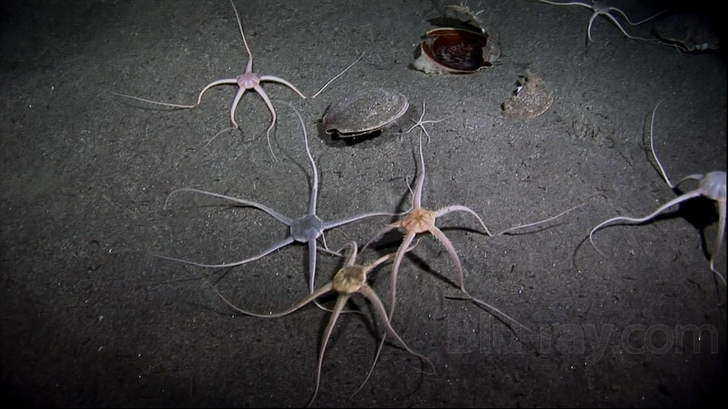
Unlike the shoddy video quality, we are given a lossless DTS-HD MA 5.1 audio track that is guaranteed not to disappoint. Since this is a documentary, explosions are kept to a minimum (though there is one incredible scene that involves a long chain of dynamite), so don't expect much from your subwoofer. I doubt you'll be concerned with that once your surrounds come alive with one of the many choir renditions set to beautiful shots of Antarctica. There's just something about clean, crisp vocal music that enhances the majesty of nature, and makes you feel like you're watching something awe-inspiring. Another excellent feature of the audio track was the segment on seal calls. During the scene, researchers put their ears to the ice, and we are given a lengthy taste of what the scientists hear on a daily basis. The sounds are differentiated across the sound field, and make you feel as though you are surrounded by a family of seals conversing with one another. Fortunately, the volume levels were nicely balanced throughout the feature, and I never found myself rushing to turn up the volume when someone was being interviewed.
In addition to the lossless track, we have a Dolby Digital 5.1 track, and a Linear PCM 2.0 track (both also presented in English). Though it lacked the clarity and robust nature of the lossless track, the Dolby Digital track is still decent, and should sound just fine to those that do not currently have the capability to reproduce the superior track. The 2.0 track is front-heavy, and should be avoided at all costs.
Encounters at the End of the World Blu-ray Movie, Special Features and Extras 
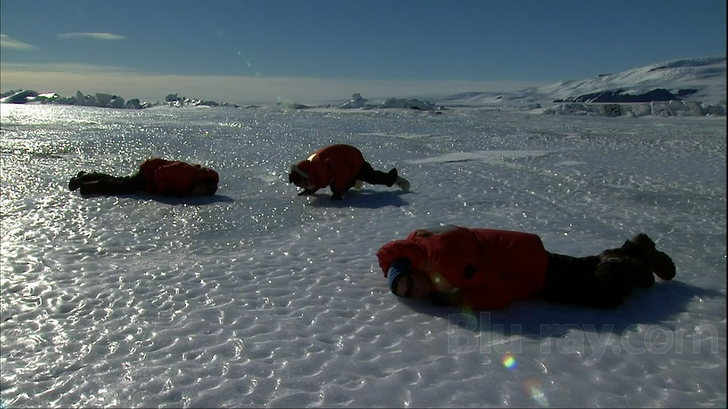
Audio Commentary with Werner Herzog, producer Henry Kaiser, and cinematographer Peter Zeitlinger (Dolby Digital 3.0): I was a little skeptical about the commentary track considering we already have a feature-length narration on the main feature from Herzog. But I'm pleased to report this is an enlightening commentary track, full of insight, background, and even several philosophical discussions. Zeitlinger rarely speaks, but it was entertaining to hear Kaiser engage him occasionally to ask specific questions about shooting locations or the lighting he uses.
Under the Ice (1080i, Dolby Digital 2.0, 35 min.): Unlike the main feature on the disc, this supplemental film (directed by Henry Kaiser) contains zero narration, but offers a lengthy collection of additional underwater footage, that is nearly as breathtaking as the scenes found in Herzog's film. The guitar strumming from Kaiser can get a little repetitive at times, and you may end up hitting fast-forward on a couple of occasions, but this is still a welcomed inclusion that is worth a single viewing (the underwater footage of a playful seal is a real highlight).
Over the Ice (1080i, Dolby Digital 2.0, 10 min.): This is truly a must-see supplement, since it offers scenery from Antarctica that is not seen in the main feature. According to a written description at the beginning of the feature, Herzog had three remaining hours of helicoptor time after shooting footage out at the dive station, so he requested a fly-over of the McMurdo Dry Valley. The mountains are daunting and vast, yet beautiful to witness.
Dive Locker Interview(1080i, Dolby Digital 2.0, 18 min.): It is clearly stated at the beginning of this supplement, that the footage from this interview will be more relevant to those with a knowledge of scuba diving than to the general public, and I would tend to agree. The interview takes place in the dive locker in McMurdo Station, and features the dive supervisor Rob Robbins. This feature is somewhat interesting, but drags on a little long, and seemed to be thrown together (as if Herzog and Kaiser suddenly received word that Robbins could take 20 minutes to meet with them, but didn't have time to prepare).
South Pole Exorcism (1080i[4:3}, Dolby Digital 2.0, 12 min.): This is a short film completed by Henry Kaiser in 2001, when he first visited Antarctica on a writer/artist grant. Kaiser intended to make a solo-guitar CD during his trip to Antarctica, and also chose to participate in some strange local activity while he was there. During the supplement, Kaiser attends an exorcism of a machine that was felt to be possessed by something strange. It's a slightly amusing look at the lengths people will go for entertainment in isolation, but is largely just a waste of time.
Seals & Men (1080I, Dolby Digital 2.0, 4 min.): I'd hoped for some impressive footage of the seals, but the majority of this supplement just features men and women walking around, with some occasional close-ups of the seals themselves.
Interview with Werner Herzog and Jonathan Demme (480p, Dolby Digital 2.0, 67 min.): This lengthy interview is done in front of an audience, and includes a collection of questions about the whole catalogue of Herzog's films. Some questions are interesting, but I felt Demme went on too long in offering praise, rather than allowing Herzog a chance to answer more questions. It's still a nice supplement, and fans of Herzog's other films will find a lot to like in this interview (which took place shortly after the release of Rescue Dawn).
We also have a trailer for Encounters at the End of the World, offered in 1080i.
Encounters at the End of the World Blu-ray Movie, Overall Score and Recommendation 
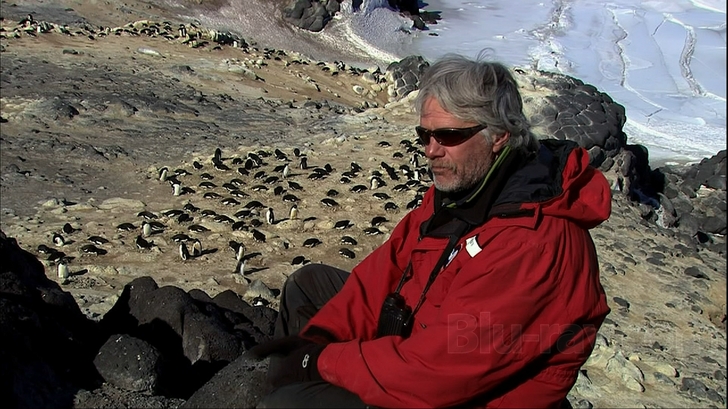
The disappointing video quality is something I have trouble getting past in my recommendation of this Blu-ray. The documentary itself is well worth seeing, and this Blu-ray edition is currently the best way to view it, but I cannot recommend a purchase, and would merely suggest you run out and rent the film. Perhaps a better edition will see the light of day eventually, and I'll have the opportunity to view the film without any distracting video problems. If that day ever arrives, I'll give this film my full recommendation.
Similar titles
Similar titles you might also like

La Soufrière
1977

Color Adjustment
1992

Leviathan
2012

Tommaso
2019

Samsara
2011

Heartworn Highways
1976

Cameraperson
2016

Nudist Life
10 Days in a Nudist Camp / Shangri-La Forbidden Fruit: The Golden Age of the Exploitation Picture, Vol. 14
1961

Tiny: The Life of Erin Blackwell
2016

Streetwise
1984

The Beales of Grey Gardens
included with "Grey Gardens" release
2006

F for Fake
1973

The Maestro: King of the Cowboy Artists
1994

Tokyo-ga
included with "Late Spring" release
1985

Minding the Gap
2018

How to Eat Your Watermelon in White Company (and Enjoy It)
included with "Melvin Van Peebles" box set
2005

Vernon, Florida
1981

The Story of Film: A New Generation
2021

The Salt of the Earth
Le Sel de la Terre
2014

Hollywood Chinese
2007
